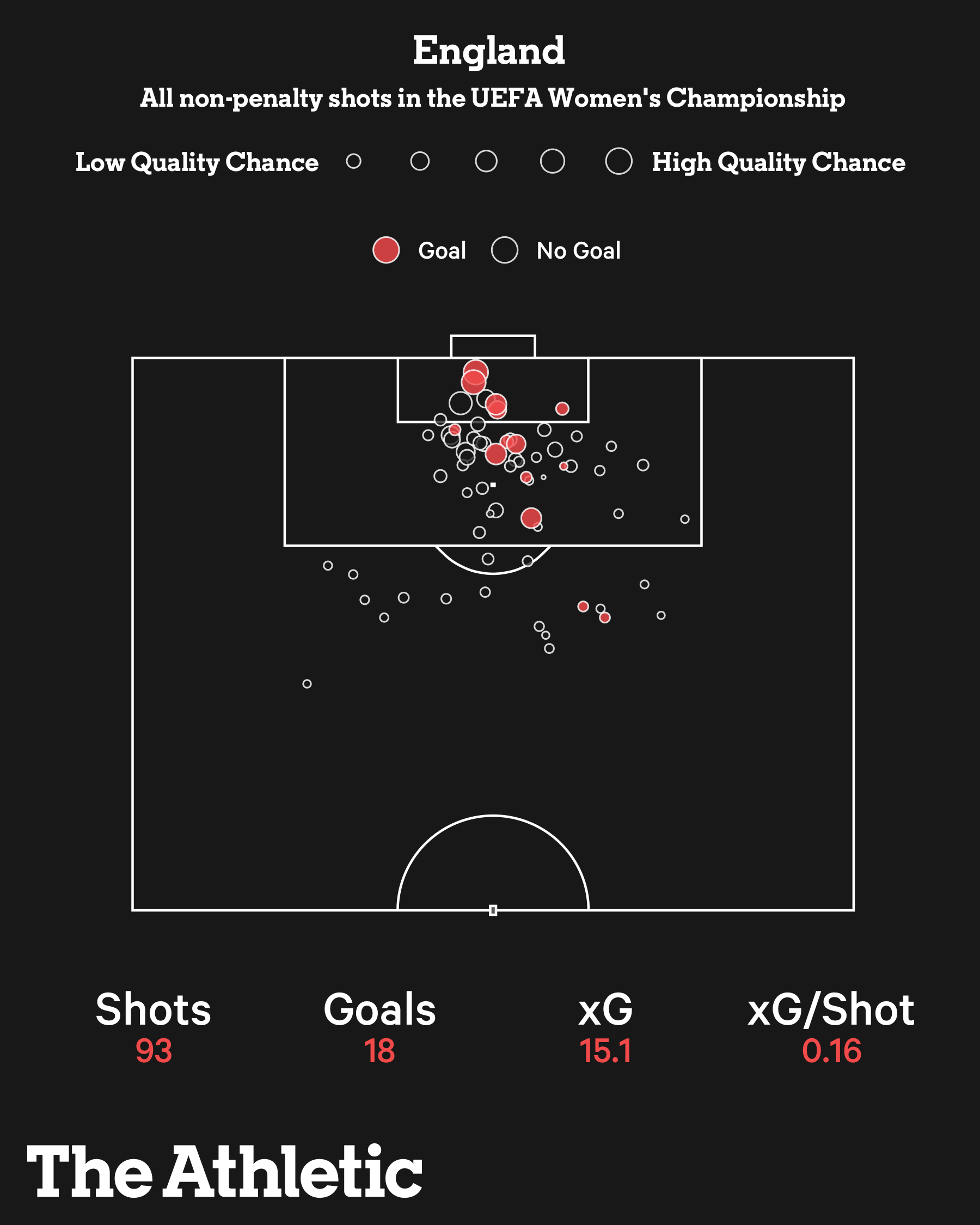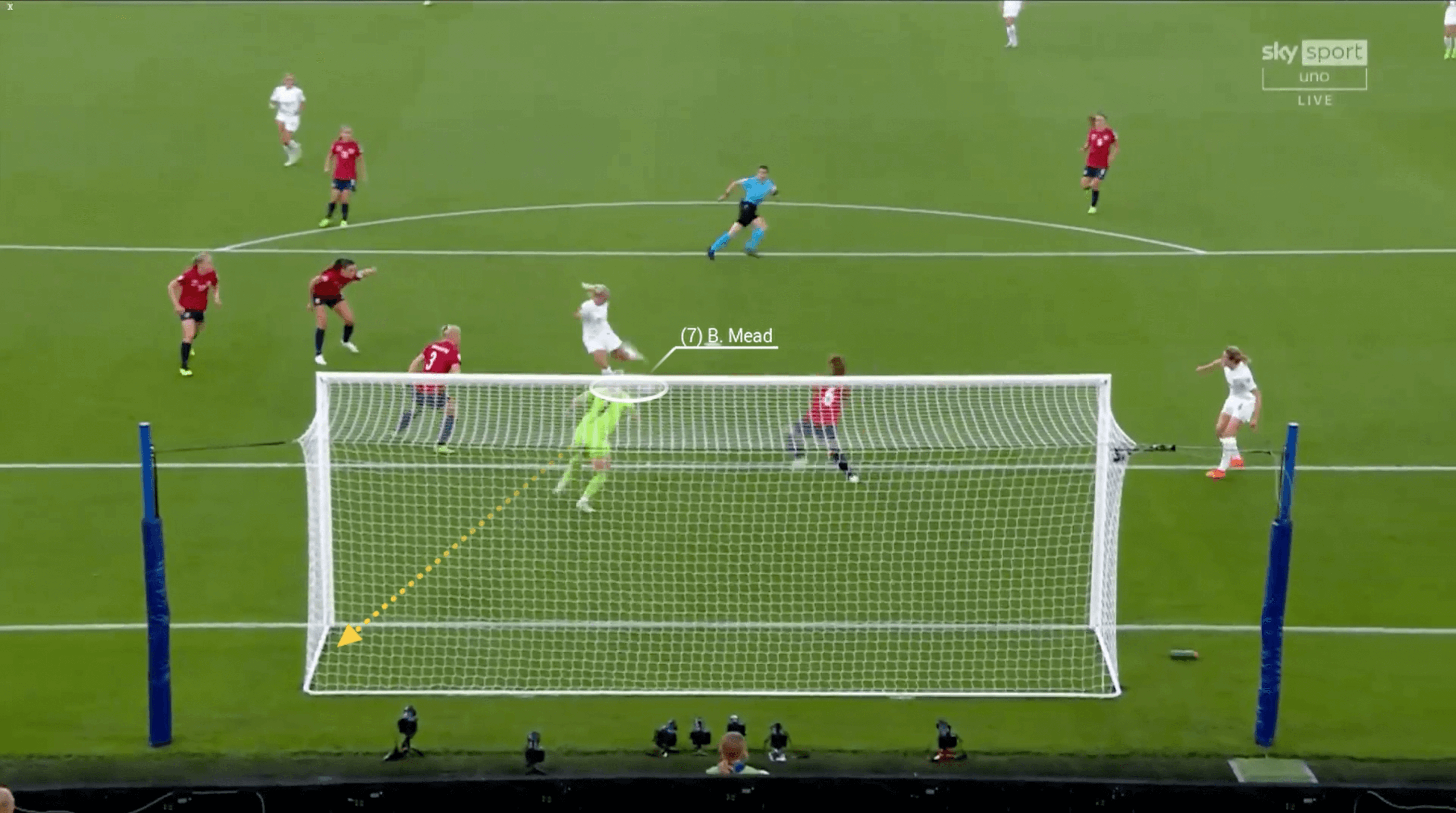Follow our live coverage of England vs. Germany in the Women’s Euro 2022 final.
England have scored goals for fun at Euro 2022 and broken tournament records along the way: Sarina Wiegman’s side scored the most goals in a group stage (14), recorded the biggest margin of victory ever (demolishing Norway 8-0) and specifically in a semi-final, with all four goals against Sweden scored by different players.
England's 16 goals in 60 seconds 🙌
Just because… 😉#WEURO2022 #Euro2022 #BBCEuros #Lionesses pic.twitter.com/EvRsGtxpR4
— BBC Sport (@BBCSport) July 26, 2022
The team’s shot map shows how England repeatedly create quality chances between the posts and close to goal. Though they have slightly outperformed their expected goals (xG), clinical finishing is essential for tournament football success.

Here are the key tactical trends from England’s goals at Euro 2022…
Assists from the right, not the left
Michael Cox analysed England’s exploitation of Norway’s left-hand side in the record-breaking win. Half of the goals were assisted from the right, with an impressive variety of aerial crosses from the channel (goals two and seven) and combination play in wide triangles to generate cut-back opportunities in the right half-space (goals four and six).
For the third goal against Northern Ireland, Ella Toone and Beth Mead combine neatly on the edge of the box. The former slides the latter in behind (blue arrow) and into a crossing position…

…Mead crosses with her first touch. England are well stocked in the box — Fran Kirby holds her run for a cutback, Lauren Hemp locks off the back post and Alessia Russo is positioned between the posts. She is in the best position to score, and she does, heading the cross into the bottom-right corner.


England rank joint-second for headed goals in this tournament, with four. This edition of the Euros has seen upwards trends in headed shots, goals and headed-shot conversion rate.
Their opener against Sweden was another for the right-wing assists tally.
Hemp’s cross from the left is marginally overhit and rolls through to the right flank. Lucy Bronze whips in a first-time delivery to Beth Mead…

…the forward controls with her first touch and scores with the second. Mead generates shot power using the laces and fires across the goalkeeper.

In the previous round, England’s equaliser was created down the right. Georgia Stanway slides a pass into Hemp, positioned behind the Spanish defence…

…Hemp’s in-swinging cross finds Russo, and drops for Toone to restore parity.



Ultimately, personnel largely explains England’s right-sided assist dominance. With Rachel Daly inverted at left-back, she advances and overlaps less than Bronze at right-back. On the left wing, Hemp is naturally a direct dribbler, whereas Mead (right wing) creates with and for others more, typically in passing triangles with Bronze and Stanway.
Advertisement
But England are reflective again of the tournament trends; as analysed in this UEFA article, former Belgium head coach Anna Noe noted “an evolution in wing play…with not so much emphasis on the traditional overlapping runs by full-backs and a greater tendency for them to use the inside channels or to deliver early crosses.“
UEFA technical observers quantified wing play as the primary assist method in the group stages, supplying 27 per cent of open-play goals.
Super substitutes and attacking style
Much has been made of Wiegman’s “ruthless” team selection and lack of squad rotation, but the head coach has used substitutes effectively when it comes to goalscoring. StatsBomb data, via FBref, shows that England have made the second-earliest changes at the tournament (average of 29 minutes played per substitute).
Collectively, England substitutes have taken 25 shots, bettered only by France (29), but notably double that of final opponents Germany (12) — substitutes could decide the game.
Russo has been the star performer in that regard, topping the charts for shots (12) and, more importantly, goals plus assists from the bench (five).
Her most stylish goal was what she modestly described as a “lucky” backheel versus Sweden.
Daly plays into Kirby, positioned high on the defensive line. She bounces a pass into Keira Walsh, making an attacking triangle…

…and Walsh turns out of pressure smoothly, opening up a passing angle back to Kirby.

Walsh feeds Kirby, splitting the defence.

Mead’s near-post run pulls away a defender and creates space for Russo, but her first effort is straight at the goalkeeper…

…but she casually backheels in the rebound.

As a substitute, Toone has been directly involved in 13 shots (eight taken, five chances created), among the top five at the Euros.
The pair combined for England’s fourth against Northern Ireland.
Facing a mid-block, Leah Williamson breaks the line into Toone. Cleverly, Toone drops into the pocket of space late to receive unmarked. Note Russo’s position behind the defence, who cannot watch her and the ball simultaneously.

Toone receives on the half-turn and finds the feet of Russo. She was actually making a run for a through ball, but reacts and takes her first touch on the spin to carry the ball forwards…

…before scoring one-v-one.

Notably, that goal is the only occasion when England have scored from an open-play passing sequence of 10-plus passes. This is despite the significant majority of England’s goals being from open play (17 out of 20) and their high-possession style.

Despite dominating possession, England have scored more from high turnovers (four — the most in the tournament) and created goalscoring opportunities with incisive, quick passing combinations and direct running.
Beth Mead and the second six-yard box
England’s golden girl this tournament has the most goals (six) and joint-most assists (three). In an interview with the England YouTube channel, Mead said she has surprised herself but attributed her strike rate to her days as a centre-forward. She said she knows “what a No 9 likes… being in the right areas of the pitch”.
No player has ever scored more goals at a single edition of the UEFA Women's Euro than Beth Mead (6)🥇🏴#WEURO2022
(Via @OptaJoe) pic.twitter.com/aUG4hh0M9N
— The Athletic UK (@TheAthleticUK) July 26, 2022
Assessing her shot map from the semi-final, we see a cluster of goals centrally in the second six-yard box, located between the actual six-yard box and penalty spot.

Goals scored there are typically one-touch finishes, but a key aspect of Mead’s play has been taking extra touches before shooting. This has allowed her to get the ball closer to goal, increasing the chance quality. Additionally, it gives her more time to pick a spot and decide how to finish, and makes the strike easier — the ball is lower in the air and is spinning less.
Exhibit A: Mead versus Northern Ireland. The ball drops to her from a cross off the second phase of an England corner.
She could shoot towards the top right corner (red arrow), but is under pressure and has low shot clarity. So she chops back onto her left foot…

…via a slight deflection, she finds the bottom left corner with a left-footed finish.

Kirby and Mead have directly combined for three goals between them, making them England’s top goalscoring pair.
Kirby set Mead up for the tournament’s opening goal with a delicate chip in behind…

…and Mead lobs the goalkeeper.

And the pair combine again against Norway. England recover possession from a Norway goal kick, with Walsh playing to Ellen White, who flicks one touch onto Kirby.

Kirby quickly plays into Mead, positioned high and on the outside of the Norway defence.

As Julie Blakstad tries to show Mead outside, she chops back inside and takes her out of the game. Mead uses the instep of both feet to neatly shuffle the ball forward, again getting closer to goal and improving the shooting angle.

Mead, with her non-dominant left foot, pulls the ball into the bottom-right corner.

Composure and finishing versatility have underpinned Mead’s goalscoring — she has scored left-foot, right-foot and headed goals at this European Championship.
It is always challenging to decipher trends at major tournaments, particularly at team level where games are so limited. But this exciting England team are deservedly winning hearts and games with their ruthless attacking performances.
Wiegman’s side will likely have to add to their goalscoring total if they are to take the trophy on Sunday evening. England face Germany, and their opponents may be the toughest nut to crack. Germany are yet to concede to an opposition player in this tournament, with an own goal by goalkeeper Merle Frohms the only blemish on their otherwise impeccable defensive record.
